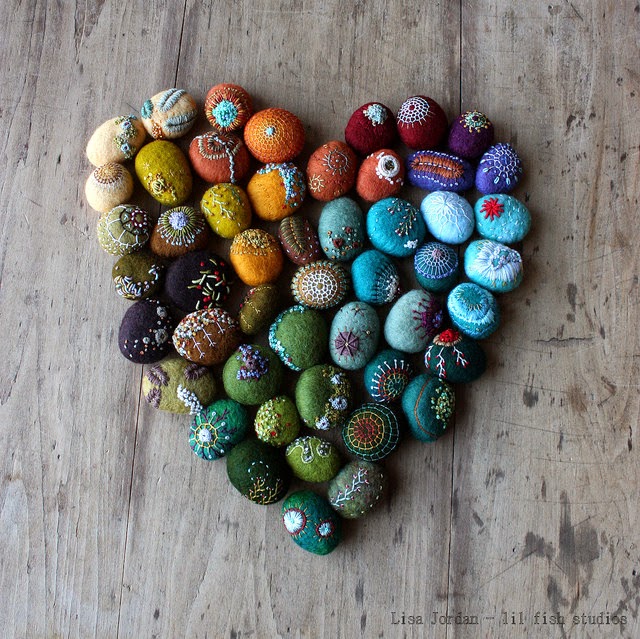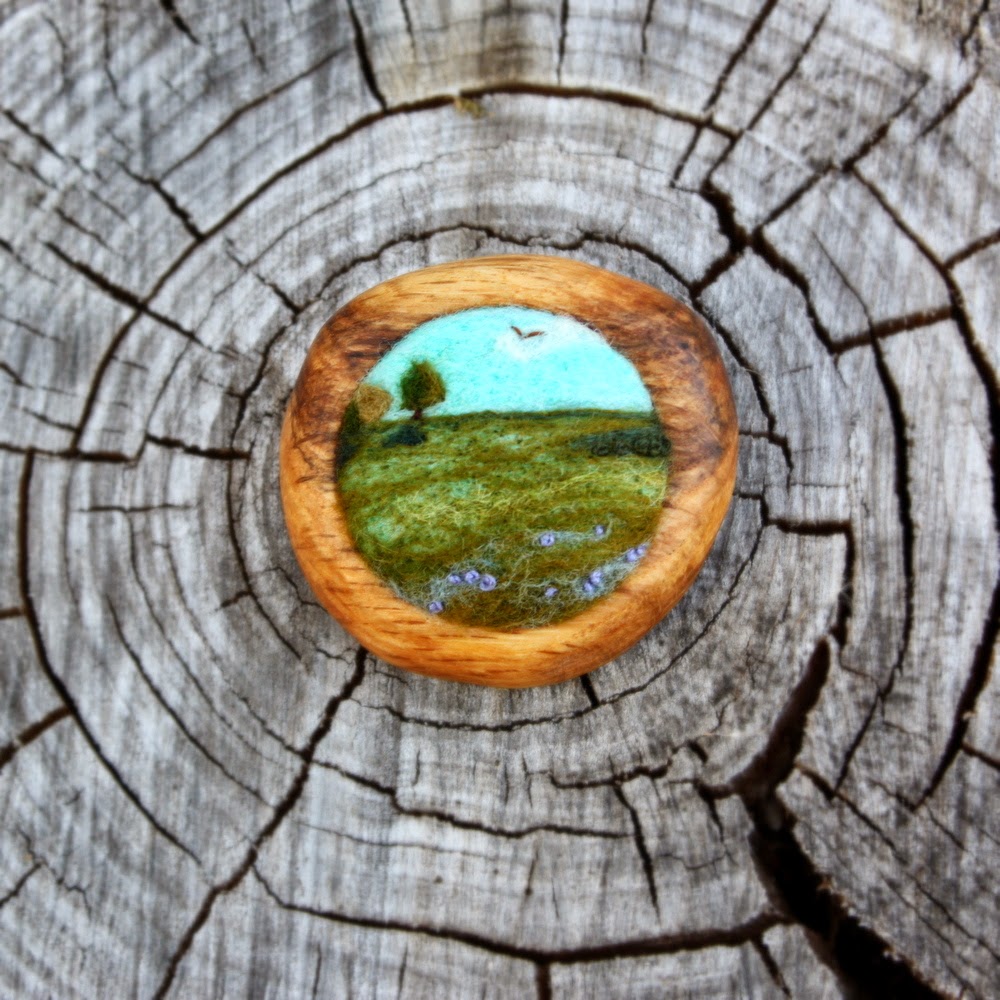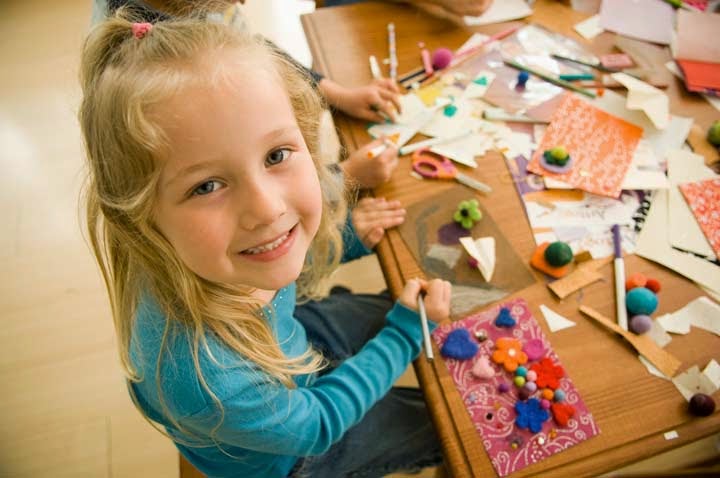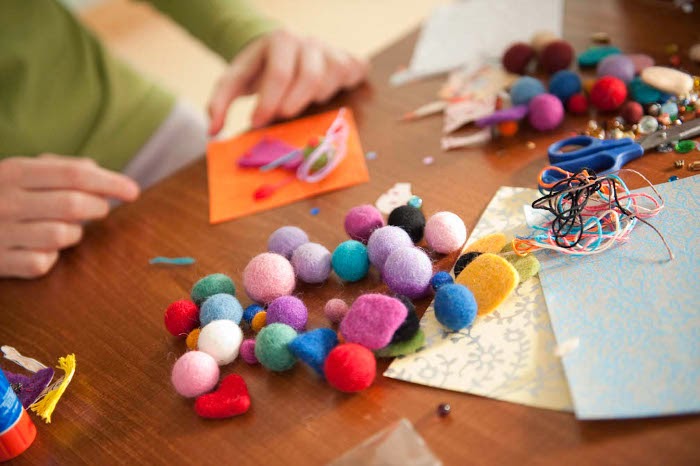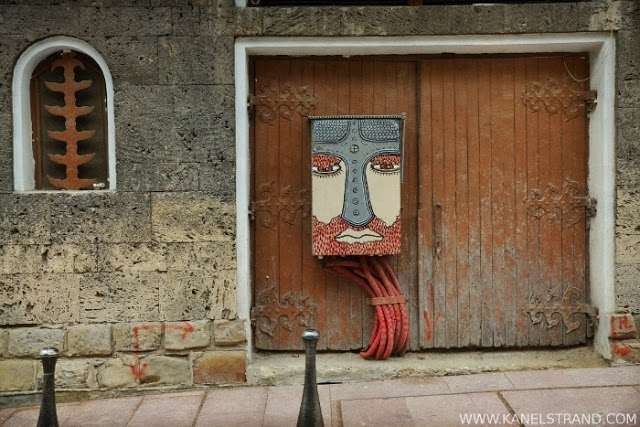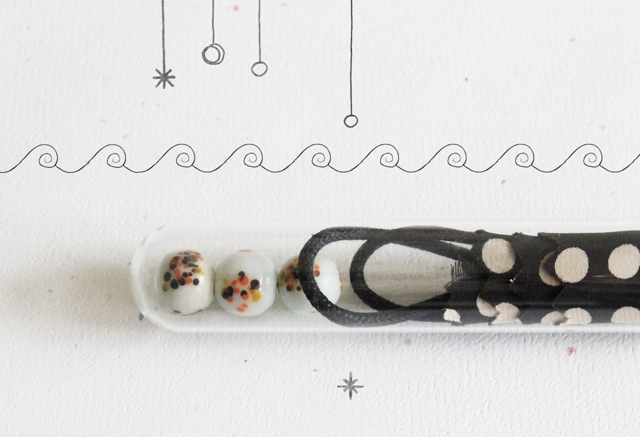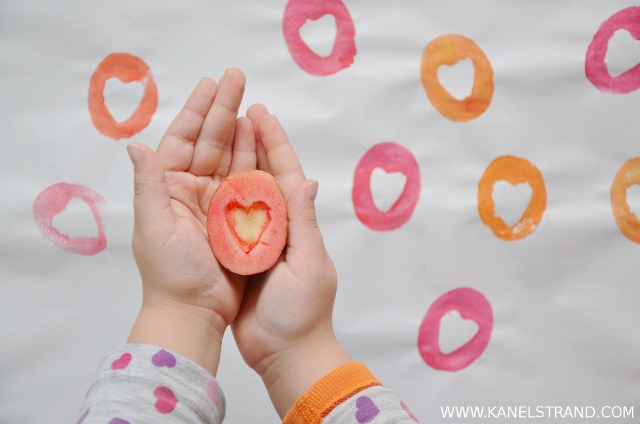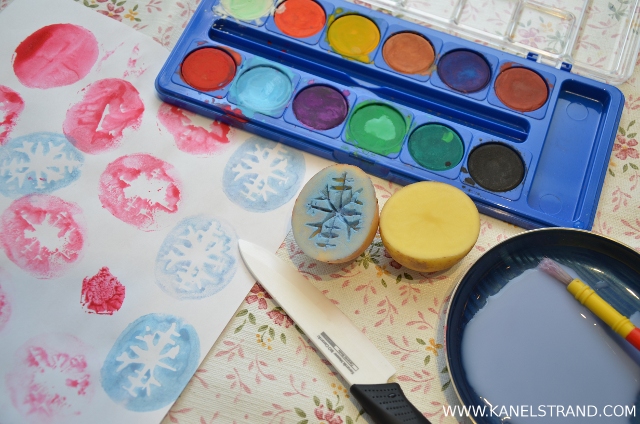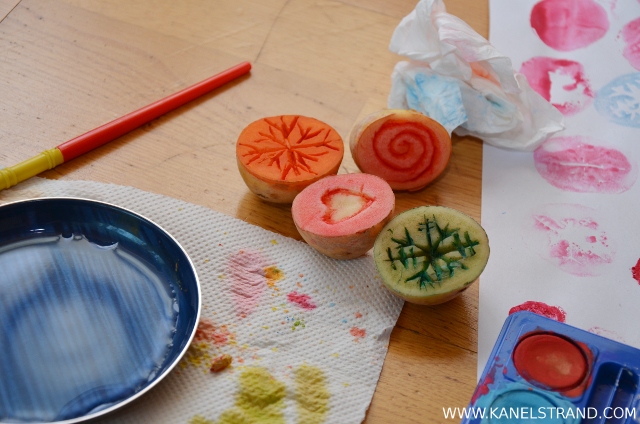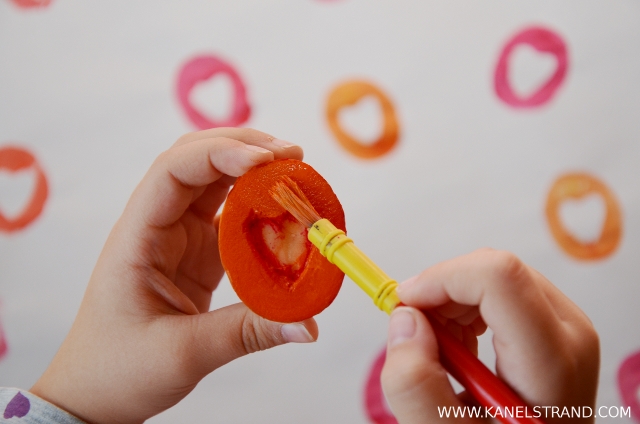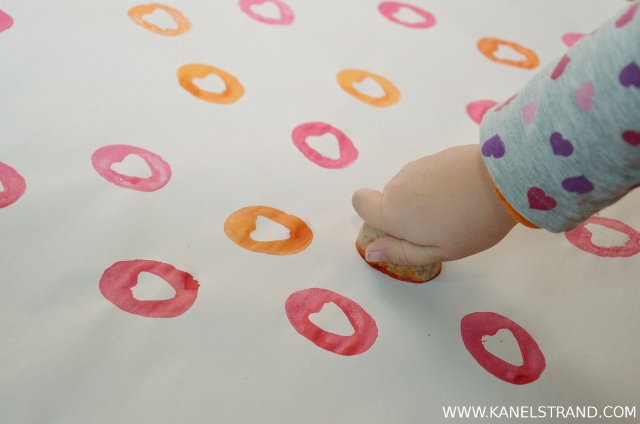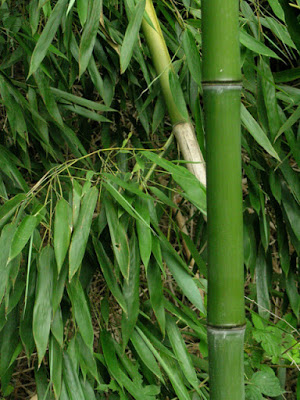In today's edition of our handmade interviews I'd like you to meet Lisa Jordan, a very inspiring wool artist living the rural life in the woods of Minnesota. She creates art that reflects the variety of textures and colors around her. The tiny worlds of fungi, moss, and lichens are particularly intriguing to her. Lisa uses primarily recycled and natural materials in her work, especially wool and wood.
Apart from making intricate designs out of felted wool, Lisa shares her creative process, inspiration and daily musings on her blog, Lil Fish Studios.
How did you start crafting?
I can’t remember a time when my hands weren’t busy making something, but about 8 years ago I left the corporate world to raise my children, and at about the same time I discovered the joy of working with wool. I’ve been hooked ever since.
Why are you passionate about handmade?
I think the act of making something by hand, whether a scarf, a pie, whatever, is a loving act. Pieces made by hand have the maker’s story woven in them; they’re personal, and I value that connection.
How and where do you sell your products?
I am incredibly lucky that through the years I have connected with “my people”… people who read my blog and who really “get” where it is I’m coming from in my work. When I have pieces to sell, I do so mostly through my online shop. I also participate as an Art-o-mat artist and some of my small pieces appear in Art-o-mat machines around the United States.
How much influenced do you get by the Internet in your creativity?
I see work online often that I think is thought-provoking or beautiful or clever and it makes me feel the urge to get up and do my work. I can’t say I find my inspiration in the pieces themselves, as I’m at a point in my creative process where I’m focused on translating my own thoughts on nature to wool, but seeing others being creative makes me appreciate how incredible and varied we are, and makes me want to join in the fun.
Do you remember the first time you held a magazine your work was featured in? What was the feeling?
I do! I had made some gift tags out of old sewing patterns and CRAFT put a little picture of them in their magazine and sent me a t-shirt. I was beyond excited then, and still get a thrill when something of mine shows up in print. That will never become old hat for me. (and I still have the t-shirt)
How is your family involved in what you do?
My young children love to sit down and needle-felt with me or stitch stones, and can point out many natural dyestuffs when we’re out for walks in the woods. My husband will sometimes cards wool for me and good-naturedly deals with bowls of stones and bins of fiber crowding the dining room table. Our life here together under poplar and pine is integral to how I relate to nature and without it, my work would be very different.
If someone wrote a biography about you, what do you think the title should be? “Crafting a Life Under Poplar and Pine” it’s my blog tagline and a reminder for me that I’m crafting this life, not just along for the ride.
If you had six months with no obligations or financial constraints, what would you do with the time?
That’s a difficult scenario to imagine, but I suppose I’d do less “doing” and more “being”.
What does "being creative" mean to you?
It means valuing the process and result of self-expression, and that can come in many forms.
What advice do you have for people wanting to be more creative?
Stop thinking that you aren’t, and open your eyes to the ways in which you are. I hear so many times from people who say “I’m just not that creative” because they’re comparing themselves to someone else, and that’s not fair. Everyone comes from a different place, and has different stories. Take joy in exploring yours.
Connect to LIsa:
blog | shop | facebook | twitter | pinterest | flickr
Showing posts with label creativity. Show all posts
Showing posts with label creativity. Show all posts
28 April 2014
02 April 2014
How to Simplify Family Craft Time
One of the goals I have for my business is to inspire people to explore their own natural creativity. At Artterro we believe everyone is born creative! But sometimes the pace of our modern lives gets in the way of that impulse to create, and arts and crafts project can seem like one more item on your endless to-do list! So my hope is with this post, it will become a little easier to incorporate arts and crafts into your family's daily rhythm, no matter how short on time and space you may be. It really can be easy! You don't need a gorgeous family art studio right out of Dwell Magazine, or a walk-in closet full of high-end materials. Just a couple of shelves or drawers, a place to sit, and a few essential, affordable supplies.
Here are some simple steps to get started:
1. A Simple Art Supply List for Kids
Kids really don't need fancy art materials when they are first learning to draw, color, and create, just child-sized tools that work well. Here's a shopping list to use as a guide (and you can also “shop” in your own home—you might have a lot of this tucked away already!).
- plain paper
- colorful paper
- plain journals or mixed-media paper pads
- glue sticks or glue
- coloring tools (crayons for younger kids, colored pencils and markers for older kids)
- kids scissors (with rounded edge) for younger kids and quality scissors for older kids (make sure they are the right size)
- storage container for paper and tools (folders, shoe boxes, jars, etc. can work great!)
- recycled materials from around the house (magazines, newspaper, empty plastic containers, ribbons, wrapping paper, etc.)
2. Family Art Supply Storage
Set up a small family art station at or near a convenient table. I find that most kids like to be near adults or other family members when they create, so the kitchen is a great central location. I use a combination of baskets, magazine holders and cups in my art cabinet at home--feel free to be creative when you look for containers. And don't worry too much about being perfectly organized. They're art supplies, not library books!
3. Make Art Happen!
Have the station where your child can easily reach it, and teach him or her how to get materials and how to put stuff away. Young kids love being independent, and it's great to build on that skill at an early age. Drawing can be a fun and relaxing thing for kids to do in the evening when they are waiting for dinner. It's also a great time to spend together at the end of a long day. And any time you can sit down and do a family art project with an older child or tween, it's such a great opportunity to talk.
Let me know in the comments if you have questions about what materials to buy or how to organize your family art station!
More resources:
Check out all the recycled containers utilized in this organized art cabinet, from The Art of Simple blog.
Last year on the Spark blog we talked about the convenience of having a mobile art station (for kids or adults).
A fun selection of supplies to jazz up your stock of basic essentials, on the Design Mom blog.
Check out our selection of Eco Art Kits—sometimes a kit is just what you need to jumpstart your family’s creativity!
03 October 2013
Street Art in Bulgaria: The Knight
The Year of Simple Living in Bulgaria has started. We have immersed into new traditions, and a totally different outlook on life but one thing is sure, the people in this country are creative.
I have never felt fascinated by street art. But as I go along the cobbled streets of historical towns I cannot fail to notice and to document so many beautiful paintings that blend perfectly with their surroundings.
How about I share some of them with you? Let me start today.
Look at this red-bearded knight, it seems that his beard is stuck under the door, maybe that's why there is sadness in his eyes.
I have never felt fascinated by street art. But as I go along the cobbled streets of historical towns I cannot fail to notice and to document so many beautiful paintings that blend perfectly with their surroundings.
How about I share some of them with you? Let me start today.
Look at this red-bearded knight, it seems that his beard is stuck under the door, maybe that's why there is sadness in his eyes.
22 February 2013
Keeping in Touch: the Inspiration Care Package
This post is written by contributing author Anabel Bouza.
As someone who has been moving around a lot, I lament the fact that I'm often leaving new friends behind. Oh, the heartbreak of creating friendships, just to say farewell...
Of course, I try to see the positive: I have friends in far places! As long as they're there, I can still call that place, home. Another good thing to result from this: it forces me to come up with fun ways to keep in touch.
That's how I arrived at the idea of the inspiration care package.
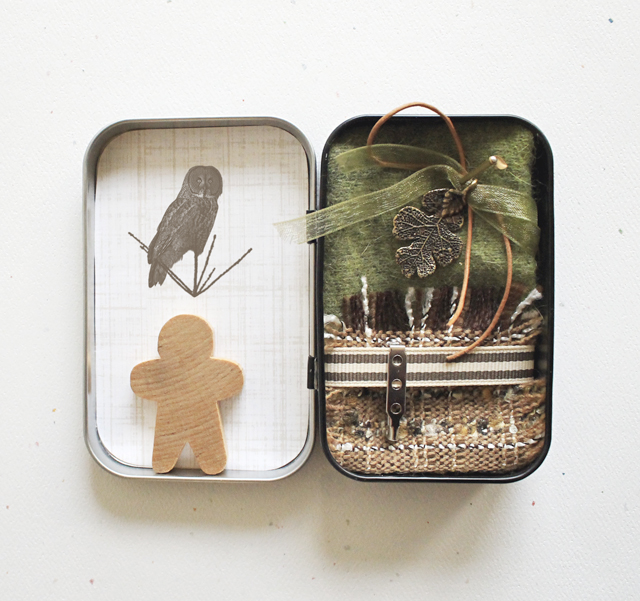 |
| Photo: Anabel Bouza |
All you need is a small tin can or similarly lidded, light-weight receptacle. As to the contents, the possibilities are endless. Some of my own ideas so far:
- A mini-project in a box: all the materials needed to create a brooch, necklace, bookmark, or whatever you can fit within the container.
- A miniature stationery set: tiny pencil, pretty paper, ribbon, wax and seal...
- A small diorama or collage, to be finalized by the person who receives it.
- A tiny embroidery project. Include the pattern — even better if it's relevant to the person receiving it — needle and thread, even a tiny embroidery loop if it fits.
- It could also be just a miniature collection of beautiful textures and colors, visually stimulating. Almost like an amulet to keep inspiration flowing!
I've been hoarding buttons, paper, and fabric my whole life, so I have more scraps and notions than the average human — although I suspect many of you are in the same situation. You're not? Well, don't feel discouraged! Just head into the world (or your cabinets) with a gatherer's mindset.
Keep an eye out for graceful twigs, cool looking train tickets, blown out christmas bulbs... Any strange little thing can become treasure!
I can almost hear the collective gasp coming from the minimalist's corner! As long as you're making care-packages with your finds, they can't accumulate and weigh you down. Actually, this may be a good way to finally do something with all the random bits of beauty you already call clutter.
I would love to know what other people do with their scraps — those too small to use in your work, yet too precious to discard.
Would you like to be at the receiving end of an inspiration care package, or would you see it as 'homework'?
This post is part of Listen to Your Heart month on Kanelstrand. Read the rest of the posts here and join in the discussions, we'd love to know what you think!
Anabel Bouza insists there's powerful magic in the action of creating something out of a vague vision, a chill of inspiration. She is an illustrator with a passion for nature, paper manipulation, and pointing her camera at things.
Her appreciation for simplicity dates back to a former life in Cuba - her strange homeland - where she refined the ability to see the alternative uses of common objects, and the enchanting side of things. She's often found blogging as Weird Amiga, hard at work in her sunny studio, or staring at things as if looking at them for the first time. Her tiny family is comprised of her husband & a turtle; they're new to the city of Chicago, and they love it. Connect to Anabel via facebook and twitter.
Anabel Bouza insists there's powerful magic in the action of creating something out of a vague vision, a chill of inspiration. She is an illustrator with a passion for nature, paper manipulation, and pointing her camera at things.
Her appreciation for simplicity dates back to a former life in Cuba - her strange homeland - where she refined the ability to see the alternative uses of common objects, and the enchanting side of things. She's often found blogging as Weird Amiga, hard at work in her sunny studio, or staring at things as if looking at them for the first time. Her tiny family is comprised of her husband & a turtle; they're new to the city of Chicago, and they love it. Connect to Anabel via facebook and twitter.
13 December 2012
Simple Christmas DIY: Make Your Own Gift Wrap
This Christmas at home we are taking simple gift giving one level up. Not only are we giving handmade gifts but we are wrapping them in paper that we decorated yourselves.
Try out this fun and quick project which will help you personalize your gifts and increase the holiday joy! It is great to do with kids of all ages.
What you need:
Try out this fun and quick project which will help you personalize your gifts and increase the holiday joy! It is great to do with kids of all ages.
What you need:
- simple white paper (make sure it is not glossy),
- watercolors,
- brush,
- small kitchen knife or utility knife.
Here is what you need to do:
1. Cut the potatoes in half.
2. Carve your patterns. We made two snowflakes, a simple swirl and a heart.
3. Use just a tiny bit of water to wet the watercolor and apply the paint with the brush.
4. Stamp! Press hard. Stamp again! And again! The amount of watercolor paint we applied was enough for 3 stamps.
4. We used the same pattern alternating between up to 3 colors on a single sheet of paper but you can do whatever suits you best. Use your imagination!
There are many great things about this project - it is very simple but also very inspirational, it can be as versatile as you decide, you can include your children or have fun doing it by yourself.
Not only will it bring a smile on your face while you make this patterned gift paper but it will surely make the people who receive your gifts feel extra special!
Apart from being handmade, your gift paper this year will also be eco-friendly and it will be reused, I am sure, because who would want to throw so much beauty away?
Good luck and have a wonderful holiday season!
Not only will it bring a smile on your face while you make this patterned gift paper but it will surely make the people who receive your gifts feel extra special!
Apart from being handmade, your gift paper this year will also be eco-friendly and it will be reused, I am sure, because who would want to throw so much beauty away?
Good luck and have a wonderful holiday season!
25 August 2012
A Word on Originality
This post is written by contributing author Anabel Bouza.
Inventors are the trailblazers that succeed at connecting invisible dots before anyone else.
Much training goes into sharpening these dot-connecting skills - we go to school for it, or spend a ridiculous amount of time improving upon our innate gift - and yet, aren't these proverbial dots readily available to everyone? Why don't we stumble upon truly brilliant solutions more often during our creative endeavors?
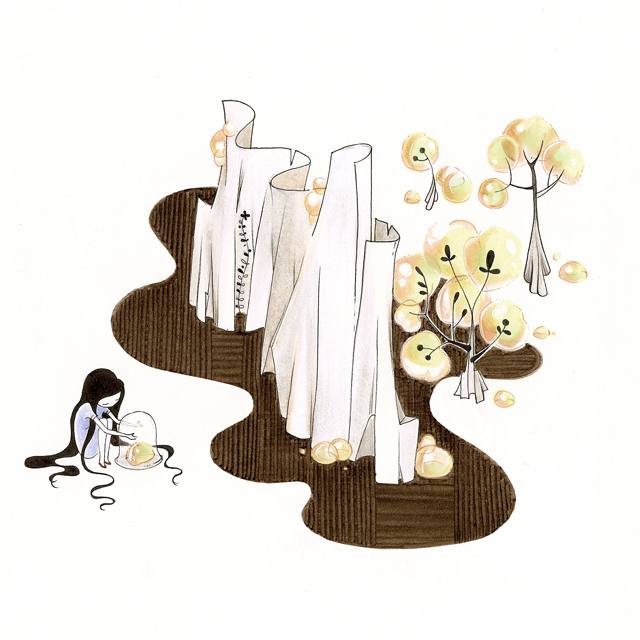 |
| Illustration by Anabel Bouza |
When creating something, we ride successive waves of ideas. We follow this or that accident down a path, chasing perfection in fragments. Eventually we encounter a thing of beauty, hungrily recognize it as a success, and clasp our hands around it.
Could it be that Beauty is, in this case, getting in the way of true creativity? Are visual artists aesthetes first and creative second?
Emily Levine said that in the finished object, all the possibilities have collapsed into one. By stopping whenever we get that glimpse of beauty, we effectively desist at the threshold of less explored variations. Maybe the hastily adoption of a first good result is a hazard to genuine innovation.
This learned and rarely questioned knee-jerk behavior could be likened to a ship that takes us from one destination to the next, safely and without event: no sea monsters to overcome, but no sight of undiscovered shores, either.
This learned and rarely questioned knee-jerk behavior could be likened to a ship that takes us from one destination to the next, safely and without event: no sea monsters to overcome, but no sight of undiscovered shores, either.
Anabel Bouza insists there's powerful magic in the action of creating
something out of a vague vision, a chill of inspiration. She is an
illustrator with a passion for nature, paper manipulation, and pointing
her camera at things.
Her appreciation for simplicity dates back to a former life in Cuba - her strange homeland - where she refined the ability to see the alternative uses of common objects, and the enchanting side of things. She's often found blogging as Weird Amiga, hard at work in her sunny studio, or staring at things as if looking at them for the first time. Her tiny family is comprised of her husband & a turtle; they're new to the city of Chicago, and they love it. Connect to Anabel via facebook and twitter.
Her appreciation for simplicity dates back to a former life in Cuba - her strange homeland - where she refined the ability to see the alternative uses of common objects, and the enchanting side of things. She's often found blogging as Weird Amiga, hard at work in her sunny studio, or staring at things as if looking at them for the first time. Her tiny family is comprised of her husband & a turtle; they're new to the city of Chicago, and they love it. Connect to Anabel via facebook and twitter.
13 August 2012
Simple Poetry: I Wonder Which is Louder
The forest, the beach, the songs of birds, the waves and the wind. You've read those words so often on this blog. You know they are the road signs of my inspiration. Bright, big and flashy. Burning red. Calming yellow. They show me the way, or whisper directions in my ear. I don't mind either method.
As long as I have my eyes open and my ears can hear I will be welcoming you on my journeys of simplicity.
 |
| Photo: kanelstrand |
It is time for yet another simple pleasure of life - one that has been with me for all my conscious existence - poetry.
If you cannot write poetry, you should try - without hesitation or judgment.
If you are writing poetry, please share it with us in the comments.
For poetry should not remain hidden. It is a universal form of connection with other minds. It is a way to understand our emotions and to find our place in the world. Poetry is beneficial to our inner peace. It is an act of peace in itself.
Let us create together the world we want to inhabit.
Here is a glimpse into mine:
I wonder which is louder
the forest, or the ocean;
for both are green and restless
and are in constant motion.
the ocean has the songs
that mesmerize the sailor
of fish and mermaids blond
which push him to the border.
the forest moves its needles
like fingers on a keyboard
and in the ears of squirrels
it plays the gentlest chord,
the birds with beaks of magic
throw feathers like a curtain,
with threads of sound and frolic
entwine the forest and the ocean.
Now it's time for you to show me yours.
25 May 2012
Creativity as a Form of Magic
This post is written by contributing author Anabel Bouza.
It has been said that Art is the last form of magic that exists. I hold that to be a half-truth.
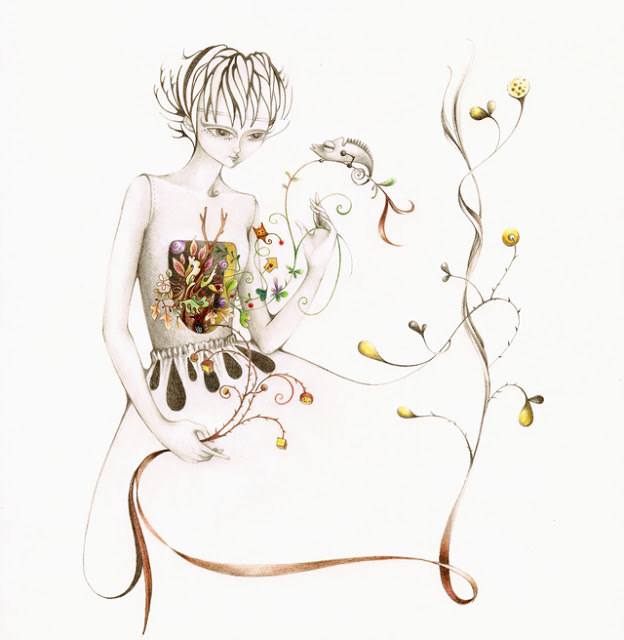 |
| Illustration by Anabel Bouza |
There is something almost supernatural associated with the act of creating, especially when we conjure the flow: that state where all anxiousness about the work at hand is swept away, and we exist outside of time. While spellbound, our hands don't stop working, nor do the mental processes needed to complete the idea.
We become a perfect vessel with a higher purpose.
So what if we can't make our visions materialize from thin air, in a burst of light. Our powers lie in the searing urge to conjure something just because we can imagine it. It's the craving within us that won't be satisfied until a challenge is resolved. It has compelled us, from the very beginning, to populate our world with novel objects and notions.
If we are infused with any form of magic, it would be the sort that allows us to peer through the veil of undreamt things, nurture an idea in the realm of the imagination, and pull it right into our dimension, materialized.
These powers are not exclusive to artists; they surge through all of us. All human invention is inherently magical.
Anabel Bouza insists there's powerful magic in the action of creating something out of a vague vision, a chill of inspiration. She is an illustrator with a passion for nature, paper manipulation, and pointing her camera at things.
Her appreciation for simplicity dates back to a former life in Cuba - her strange homeland - where she refined the ability to see the alternative uses of common objects, and the enchanting side of things. She's often found blogging as Weird Amiga, hard at work in her sunny studio, or staring at things as if looking at them for the first time. Her tiny family is comprised of her husband & a turtle; they're new to the city of Chicago, and they love it. Connect to Anabel via facebook and twitter.
Anabel Bouza insists there's powerful magic in the action of creating something out of a vague vision, a chill of inspiration. She is an illustrator with a passion for nature, paper manipulation, and pointing her camera at things.
Her appreciation for simplicity dates back to a former life in Cuba - her strange homeland - where she refined the ability to see the alternative uses of common objects, and the enchanting side of things. She's often found blogging as Weird Amiga, hard at work in her sunny studio, or staring at things as if looking at them for the first time. Her tiny family is comprised of her husband & a turtle; they're new to the city of Chicago, and they love it. Connect to Anabel via facebook and twitter.
04 May 2012
Slow Living: Summer Yarns
This post is written by contributing author Laurie Fortier.
Do the seasons affect your crafting habits? You may associate knit and crochet with an image of a cozy fire and snow falling outside the window. While this is a possible image, and one I enjoy, knitting and crocheting do not have to be put away when the weather turns warmer. I live in a very cold climate with snow on the ground six months a year. So you can be sure that as soon as the snow is gone, I am outside cleaning my flower beds and getting ready for June, when I can plant my annuals!
| Source |
But, do I give up knitting during this brief, summer respite? Not a chance! What is wonderful about the needle-arts is that they are portable. I can’t take my sewing machine to my son’s soccer game, but my knitting? You bet I can! The only difference between my winter and my summer knitting are the projects I make and the yarns I use.
We are extraordinarily lucky today to have many beautiful and eco-friendly yarns to choose from that are perfect for warm weather knitting. These are the yarns that I am going to tell you about in this post.
Cotton and flax are the two oldest plant fibers used in the production of clothing. Archaeologists have found pieces of linen 6000 years old and cotton dating back to 3000 B.C. Hemp is another very old plant traditionally used for making ropes. No, it is not the same thing as the Marijuana plant, but this resemblance gives hemp yarn a bad name!
We are extraordinarily lucky today to have many beautiful and eco-friendly yarns to choose from that are perfect for warm weather knitting. These are the yarns that I am going to tell you about in this post.
Cotton and flax are the two oldest plant fibers used in the production of clothing. Archaeologists have found pieces of linen 6000 years old and cotton dating back to 3000 B.C. Hemp is another very old plant traditionally used for making ropes. No, it is not the same thing as the Marijuana plant, but this resemblance gives hemp yarn a bad name!
| Cotton |
Cotton yarn is soft, absorbent, wears well and is machine washable. Buying organic cotton means that the plants were grown without chemicals and pesticides and less processing was used to produce the yarn.
| Harvested Flax |
Linen yarn, made from the flax plant, is 2 to 3 times stronger than cotton, highly absorbent and cool to wear.
| Hemp |
Hemp makes a fabric that is absorbent, cool, comfortable, antimicrobial, blocks UV rays and is machine washable.
Many of the new and exciting fibers are called “extruded” fibers because the plant material is liquefied, pushed through a spinneret and solidified to create fine fibers.
Many of the new and exciting fibers are called “extruded” fibers because the plant material is liquefied, pushed through a spinneret and solidified to create fine fibers.
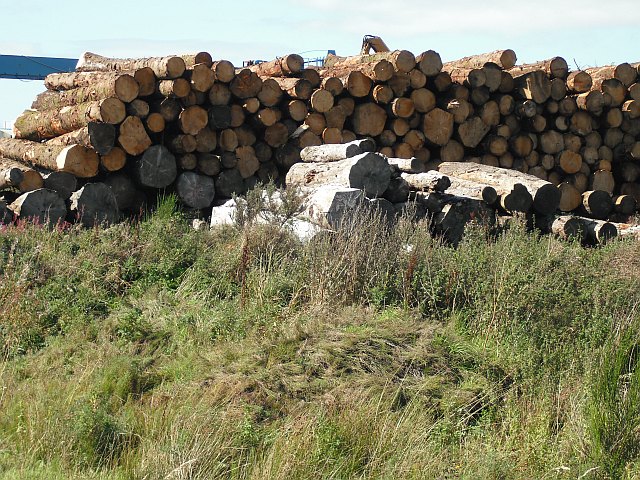 |
| Wood |
Lyocel is made from wood pulp. It has a fluid, silky drape, is breathable, absorbent and machine washable. The commercial name is Tencel.
| Seaweed |
Seaweed is combined with lyocel to create a fabric that has a fluid, silky drape, is breathable, absorbent and machine washable. The commercial name is Seacell.
Bamboo is very sustainable. It is a grass (that grows like a weed!). Harvesting doesn't kill the plant. It has a fluid, silky drape, is soft and cool to wear, antimicrobial and resistant to UV rays.
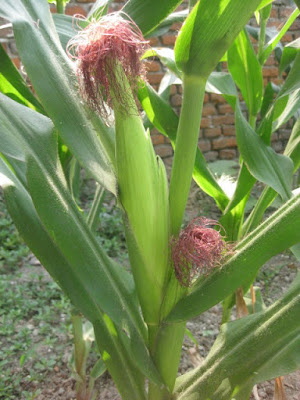 |
| Corn |
Corn fiber is lighter than bamboo, has a beautiful drape, is soft and machine washable.
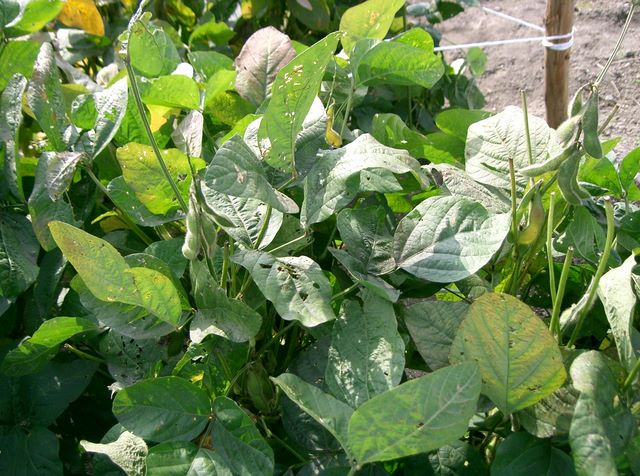 |
| Soybean plant |
Soy pulp, as an extract of tofu production, creates beautiful soft, smooth, breathable and antimicrobial fabrics that retain warmth like wool.
| Milk yarn? |
Milk - Did you say milk? But, milk isn’t a plant?! No, but a process similar to that used for extruded fibers is used to make milk yarn. It is an extraordinary fiber, beautifully soft and silky yet strong!
There you have it! A glimpse of some of these amazing fibers. One summer certainly won’t be enough to try them all!
Here is a list of just a few of the companies that produce these yarns.
There you have it! A glimpse of some of these amazing fibers. One summer certainly won’t be enough to try them all!
Here is a list of just a few of the companies that produce these yarns.
- Be Sweet for bamboo, organic cotton, recycled cotton and more!
- Green Mountain Spinnery for organic cotton and Tencel blends.
- Kollage for many combinations, corn, soy, milk, recycled demim and more!
- Lanaknits for all things hemp.
- South West Trading Company for bamboo and soysilk.
- Tilli Tomas for a silk seacell blend.
So, how about it? Will you knit or crochet this summer? Do any of these yarns “tickle your fancy?”
The Yarn Garden by J. Marsh Michler, is the lovely book that I used as a reference for this post. It has beautiful patterns for all of these different plant fiber yarns.
The Yarn Garden by J. Marsh Michler, is the lovely book that I used as a reference for this post. It has beautiful patterns for all of these different plant fiber yarns.
Laurie Fortier has been a teacher of languages, psychology and pedagogy for over 26 years. Her passion for learning and sharing knowledge permeates everything she does. Her transition into blogging seems to be a natural step. She blogs about her love of knitting and natural fibers in addition to owning her own online yarn shop where supporting sustainable development guides all her business decisions. Connect to Laurie via twitter and facebook.
05 February 2012
Step 4: Simple Crafting for Happy People
A full list of the Simple Living Challenge steps can be found here.
I find hand work vital for the reconnection with my inner self and that is why I keep on posting DIY projects each weekend in hope that even if you think you aren't crafty enough you might find a tutorial suitable for your interests. I do know that crafting gives you wings, and yes, you can do it! You can do anything you set your mind to even if you don't know how.
My knitting story
I find hand work vital for the reconnection with my inner self and that is why I keep on posting DIY projects each weekend in hope that even if you think you aren't crafty enough you might find a tutorial suitable for your interests. I do know that crafting gives you wings, and yes, you can do it! You can do anything you set your mind to even if you don't know how.
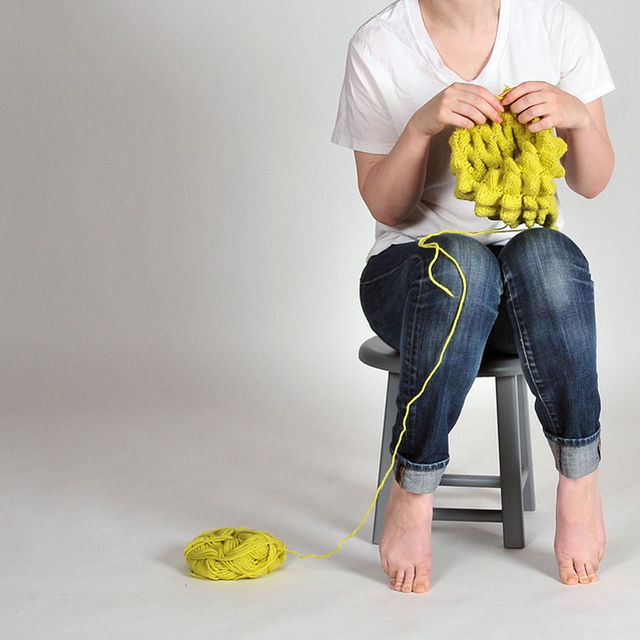 |
| Photo: saxarocks |
My knitting story
Next time you doubt yourself think of my story - several years ago I couldn't knit and I didn't know that knitting needles correspond to yarn thickness. Now I am knitting, crocheting and felting. I am selling my products on the Internet and in local shops. How did I learn to knit? All the generous knitters on the Internet taught me. I never even paused to ask myself if I would be able to make it just because I enjoyed the process and was impatient to see the results.
I didn't start with a scarf (all knitters know what I mean, for those of you who are unaware - that's the simplest project you can finish, perfect for a first-timer). I started with a hat, and then another, and yet another. And I mean hats with braids. I combined patterns without knowing anything about knitting, counting, gauge... I made mistakes and learned the hard way, with countless unravellings and starting-overs. I jumped straight at the real thing because there was nobody to tell me I couldn't do it. I guess that's the positive side of learning alone.
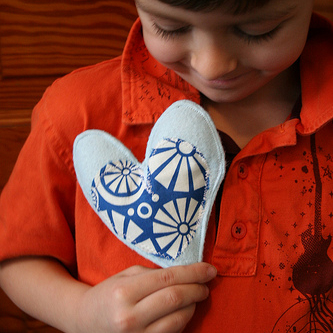 |
| Go to Maureen Cracknell Handmade for a detailed tutorial on making warm hearts. |
The trust
Next time you dismiss a DIY or craft tutorial because you think you are clumsy or have no time to finish it, think again. You can always find time, and you can do it. Just encourage yourself a little, trust yourself a bit more. Craft away and let your hands sculpt out your dreams. Of course you can do it!
The challenge
Take your crafting to another level - don't stick only to those crafts you know well or think you are skilled at, challenge yourself, go out of your comfort zone, play! Play like a little child, curious to meet the big world. What do you have to loose? Only a few boring hours.
The judgment
Make space for your crafting sessions - even if it is just 15 minutes a day, make sure you have a schedule, a daily date with that part of yourself that can craft without judgment. It is easy to combat the perfectionism we talked about in Step 1 - free up time each day (be it just 15 minutes) to craft with only one rule - no judgment. Enjoy the process, follow the movements of your hands, the smell of your supplies and the touch of your tools. Be in the process. Even for 15 minutes a day.
| Visit Crafty Little Gnome to learn how to make these cute felt fortune cookies. |
The craft
What you do is unimportant. You could consider a craft anything that involves hand work, even baking. But if you strive to get out of your comfort zone you will be rewarded.
Your hands working on an out-of-your-comfort-zone project will touch your heart and your mind. Don't be surprised by the creativity they will unlock.
Share with us: What are you crafting today?
Share with us: What are you crafting today?
See also:
Step 1: Embrace Your Imperfections
Step 2: Simple Living as Men's Trait
Step 3: The Rules of Simple Home Organization
Step 5: Simple Scheduling and Planning Routines
Step 6: Spend More Time With the People You Love
Step 7: Spend More Time Alone
Step 8: Connect to Your Inner Self
Step 9: How to De-Stress
Step 10: Learn to Live With Less and Enjoy it
Step 11: Start a Debt-Free Life
Step 12: How to Overcome Consumerism
Step 13: Declutter Your Life
Step 14: Get Rid of Toxic Cosmetics and Reclaim Your Natural Self
Step 15: Wean Off Plastic
Step 16: Celebrate Your Story
The Final Step: Gratitude
Make sure you stay up to date with the Simple Living Challenge and subscribe by email to receive each post straight to our Inbox or by RSS if you are using a Reader.
06 October 2011
How to Make Your Own Paint
A guest post by Rachel of Pthalo Azul and This is Not a Craft. If you want to guest post on this blog, check out the guidelines here.
Part of being an artist in this day and age, is to have paint and materials that people over 150 years ago never dreamed about (and we're still inventing hybrids of acrylic, oils, and watercolor that do really fun things) - however, most of it is made in a big ol factory in heaven-knows-where and heaven-knows-when.
Some artists, for this reason as well as others, like to make their own paint from scratch in their own homes. So that's what we're going to talk about today. Not only is it cheaper for the artist that uses a lot of paint, it makes less of a footprint not only on the environment but on global trade. You can buy oils and pigments from small sources and make just enough for you so it isn't just sitting on a shelf for forty years like I suspect some of the tubes in art stores are doing. The quality is much, much higher, and the paint is tailored for the individual artist's needs.
Paint isn't that complicated or mysterious when you get down to it. Its recipe is three things: a pigment, a binder, and a medium (sometimes referred to as the "thinner") that allows it to flow. Every single type of paint from oil, to tempera, to watercolor, to encaustics are made up of only these three things. (of course some paints are very synthetic, you can't really make acrylic at home, for instance)
Egg Tempura
- Powder pigment (not a lot of it - pigment is strong. Some pigment is also dangerous, so wear a mask before you've mixed it with the egg - the amount you use depends on the color and that's too complicated for this post)
- egg yolk from a freshly cracked egg
- H20
A great underused paint is Egg tempura. There really isn't a way to sell it in a tube because it's made out of eggs. It's the paint made famous by the monks of the 13th century, who perfected the technique on religious iconography. For a binder it uses a freshly cracked egg yolk (for those with chickens at home, free-range chickens are the very best eggs to use for egg tempura, and so if you haven't picked it up - you should!)
Using a palette knife against a palette, the yolk is mixed with the pigment for half a minute or so. Egg tempura is really thin, should dry really quickly once applied to the surface, and has to be built up in dozens of layers to get the rich colors seen in old artifacts. For a thinner, tempura painters use water - but too much will ruin the bond of the egg and the pigment.
I've heard you can use a watercolor pigment for egg tempura if you don't have a powder pigment (powder pigment I'll discuss later in the tutorial) and it's meant to be painted on a board primed with oil-painting gesso.
Oil Paint
- pigment
- oil (linseed oil - available at all art/craft stores - is the most popular one, but depending on the pigment people will add other types, sometimes even beeswax for an added texture)
- mineral spirits
In olden times, people would use a rock and grind away pigment into oil for hours - nowadays there's these mortar and pestles made of glass to do the mixing. It takes a while before the consistency is just right, but I hear that the process is extremely relaxing. I know it's at least really relaxing to watch. When finished, oil paint is slapped into tubes.
Check your local art store (the higher end ones) to see if there is locally hand-mixed paint. It's a little more expensive, but is a great way to support local artists. You also know that the quality is high grade and fresh.
The ratio of pigment to oil depends on the artist and the pigment. Higher grade paints use a lot more pigment - and I'm sure we've all accidentally bought that cheap red paint that took 8 coats to paint red. Its problem was not enough pigment (red pigment is very expensive). Which is why house paint will never acheive true red - they hardly add any pigment at all because it's so pricey. It's also why cheap paint is so cheap: it's missing half the ingredients.
Pigment
Almost all pigment nowadays is in a powder form that you can buy online. Traditionally, these powders were ground from things like mollusks, dirt, and in the 1800's they even tried using ground up mummies. Yes, Egyptian mummies. Of dead people. A thought so far beyond green, it's from a weird and scary ultraviolet place! So I guess it isn't such a tragedy, in comparison, that all of our pigments today are synthetically produced by just a few manufacturers.
Tea-Paint
Since this is about alternative paints, I thought I would do something that we know creates pigment but have probably never painted with. Truly, you can paint with anything, so long as it reaches the three required properties of paint (and painting with tea is probably more considered a dye, but I don't want to go into that) coffee, flowers, juice, bark, dirt, tree sap, grass, there's loads of alternative pigments, but they smell (especially the process to make ink, which is infamously smelly) and so I decided to use herbal tea.
They certainly can't last as long as a synthetic pigment, but unless you have some Futarama experience on your next pizza delivery, the chances that you will still be around in 200 years to see your painting are slim. Using good paper, framing well, and hanging out of the direct sunlight will help keep that painting looking good at least until you die.
I used several different teas that I soaked in hot water (about a tablespoon for each bag so it wouldn't take too long to sink in) and I soaked them for about half an hour before I got impatient and decided to start.
(I apologize, I am that type of illustrator that is completely incapable of drawing anyone in normal clothes. This is literally the first thing that comes off my head and I have no idea why, but my sketchbook is full of these weird-dressed chicks.)
Low quality paper won't take the tea-paint well, but high quality watercolor paper does just fine. I used a heavy lb Arches watercolor paper.
- The reds (which dried purple when done in thin washes) are from a raspberry herbal tea;
- The yellow-ochre are from a ginger tea;
- The bright yellow are from a licorice blend tea.
I was really surprised at the almost purple quality I got from the raspberry tea.
I used just a normal graphite pencil for dark lines and I'm satisfied with my tea experiment, and most wouldn't guess that used to be in a tea bag:
So I hope you give some alternative paints a spin, if not for the Earth, at least for a chance to get back to our roots, because it wasn't too long ago (about 200-300 years ago? Kay, maybe it was kind of a long time ago... ) there were no paints sold in stores - you had to make that all yourself. Making paint from scratch was once an integral part of the artist experience, and I think with the push to be more green and the push to buy locally and know where your products come from, it will gain relevancy once again.
My name is Rachel Anne Jones, Raj for short - I'm an illustrator who creates pieces for my shop, Pthalo Azul, and writes for my blog This Is Not a Craft. I live in the Bay Area south of San Fransisco, and am in love with the piano, good chocolate, tall trees, and finding ways to tell stories through art. I have a BFA in Illustration, and I've done odd jobs ranging from business cards, to painted murals, to web art, but my favorite is still working with a paintbrush and sketching in a book.
02 May 2011
Sadly Hookless
Now, here is what happens to the one who starts 3 crochet projects simultaneously! See how easy it is to get over excited by spring crafting and to become sadly hookless (I am almost sure there is no such word but it kind of goes well with the whole absurd situation, doesn't it?).
So, next time you plan to save money, remember this ugly picture and go for the quality! Note to self: Never, ever buy plastic hooks again! They are so NOT eco!
And speaking about crocheting, I am in the process of putting together a lovely how-to for all creative crocheters and adventurous ladies who are willing to try something new, so don't throw away your ragged pants and stay tuned this week for an upcycling project!
By the way, what kind of crochet hooks do you use and would you recommend them?
Subscribe to:
Posts (Atom)
